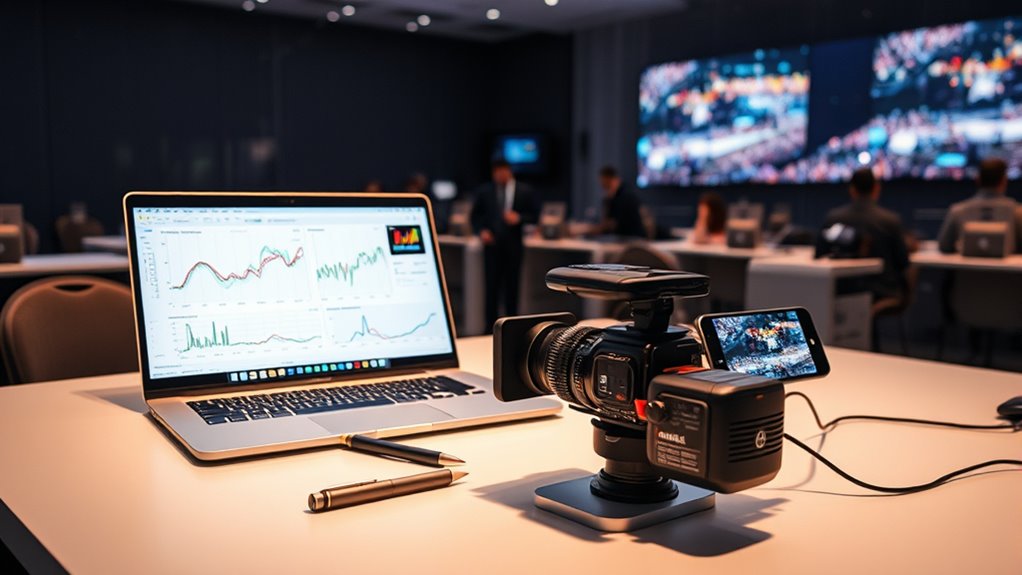Using AI tools can substantially improve your event documentation by providing instant transcription, capturing every detail accurately and saving you hours of manual note-taking. These tools also create engaging visual content like images and videos from raw footage, making your records more appealing and shareable. They help you organize and access information quickly while ensuring data privacy compliance. Keep exploring to discover how these innovations can transform your event documentation process even further.
Key Takeaways
- Implement automated transcription to capture real-time, accurate records of conversations, decisions, and casual comments during events.
- Use AI-generated visual content to create engaging summaries, infographics, and highlight reels that enhance documentation.
- Leverage AI tools for quick sharing, searchable archives, and multimedia-rich reports to improve stakeholder engagement.
- Ensure data privacy and compliance when handling sensitive event information with AI-powered documentation solutions.
- Benefit from continuous AI learning to improve transcription accuracy and visual content quality over time.

Event documentation is essential for capturing key insights, decisions, and moments, but traditional methods can be time-consuming and prone to errors. Luckily, AI tools are transforming this process, making it faster, more accurate, and more engaging. One of the most impactful advancements is Automated Transcription. Instead of manually jotting down notes or relying on memory, you can now use AI-powered transcription services to convert spoken words into text in real time. This not only saves you hours of post-event work but also guarantees that nothing gets lost or misremembered. Automated Transcription captures every detail, from important decisions to casual comments, providing a thorough record that’s easy to review, search, and share. Plus, with high accuracy rates, you can trust that the transcripts reflect what was actually said, reducing misunderstandings or the need for extensive corrections later.
Alongside transcription, Visual Content Generation has become a game-changer for event documentation. When you want to highlight key moments or create engaging summaries, AI-driven visual content tools can automatically generate images, infographics, and short videos from raw footage or event data. This means you can produce eye-catching visuals without hiring a dedicated designer or spending hours editing. For example, after a conference, AI can compile photos, speaker quotes, and audience reactions into a dynamic recap video or a compelling infographic that captures the event’s energy and main takeaways. These visual assets not only enrich your documentation but also make it more appealing for stakeholders, attendees, or social media sharing.
Using AI tools for Automated Transcription and Visual Content Generation also streamlines collaboration. Instead of juggling multiple tasks or waiting days for manual summaries, you get instant access to organized, multimedia-rich documentation. This allows you to respond quickly, share insights promptly, and make data-driven decisions with confidence. Furthermore, these tools continuously improve through machine learning, meaning their accuracy and capabilities will only get better over time. As a result, you can focus on planning and executing events rather than spending excessive time on record-keeping. Ultimately, integrating AI into your event documentation process ensures that you capture more complete, engaging, and accessible records, helping you maximize the value of every event you host.
Additionally, awareness of data privacy challenges is crucial as these AI tools handle sensitive information, and ensuring compliance with regulations is essential to maintain trust and security.
Frequently Asked Questions
How Secure Is the Data Processed by AI Tools During Event Documentation?
You can feel confident about data privacy because most AI tools use strong encryption standards to protect your information during event documentation. These tools prioritize securing data both in transit and at rest, reducing risks of breaches. However, always review the platform’s security policies. Staying informed about their encryption methods and privacy practices guarantees your data remains safe, giving you peace of mind when using AI for event documentation.
Can AI Tools Adapt to Different Types of Events Automatically?
Think of AI tools as chameleons in a vibrant jungle, effortlessly blending into various environments. They adapt to different event types through built-in AI flexibility, learning from each new experience. This allows for seamless event customization, where AI automatically tunes itself to capture unique details and dynamics. So yes, these tools can adapt to diverse events, making documentation smarter, more accurate, and tailored without needing manual reprogramming.
What Are the Costs Associated With Implementing AI for Event Documentation?
Implementing AI for event documentation involves costs like purchasing or subscribing to AI software, which varies based on features and scale, so you should consider your budget. You’ll also need to account for training requirements to guarantee your team uses the tools effectively, which might include time and resources. Overall, plan for both initial setup costs and ongoing expenses to keep the system running smoothly and efficiently.
How Do AI Tools Handle Multilingual Event Documentation?
Ever wondered how AI handles multilingual event documentation? AI tools use advanced natural language processing and translation algorithms to guarantee multilingual accuracy. They can automatically translate content into multiple languages, but translation challenges like idiomatic expressions and context can affect precision. Do you trust AI to capture the nuances across diverse languages? With continuous improvements, these tools are becoming more reliable, helping you communicate effectively in global events without language barriers.
What Are the Limitations of Current AI Technology in Capturing Event Nuances?
You might find that current AI technology struggles with capturing event nuances because of subjectivity bias and limited contextual understanding. AI systems can misinterpret subtle tone shifts, cultural cues, or emotional undercurrents, leading to incomplete or inaccurate documentation. While they excel at structured data, they often lack the depth to grasp complex human interactions fully, highlighting the need for human oversight to guarantee nuanced details aren’t overlooked or misunderstood.
Conclusion
As you embrace AI tools for event documentation, you might find yourself surprised by how effortlessly tasks become streamlined. Coincidentally, the same tools that enhance your workflow can also uncover insights you hadn’t expected, making your event reports more thorough. By integrating AI into your process, you not only save time but also gain a deeper understanding of your events. It’s remarkable how technology can transform your approach—sometimes, the best solutions come when you least anticipate them.









